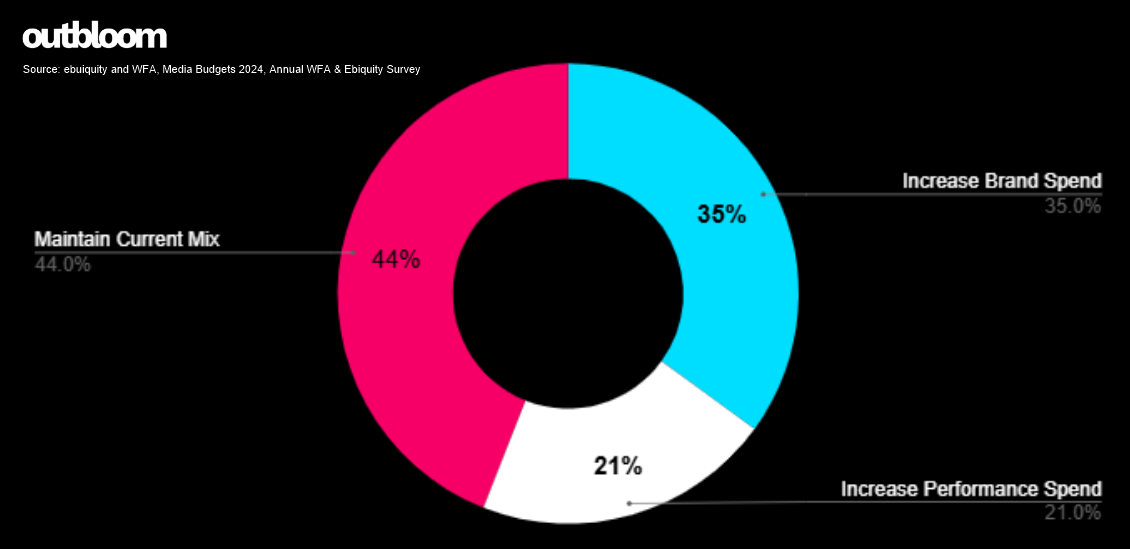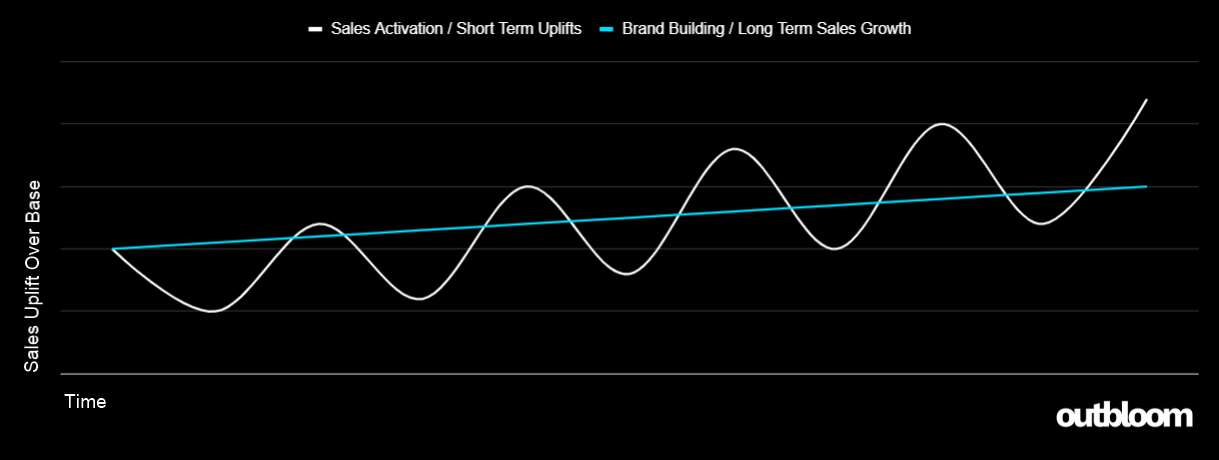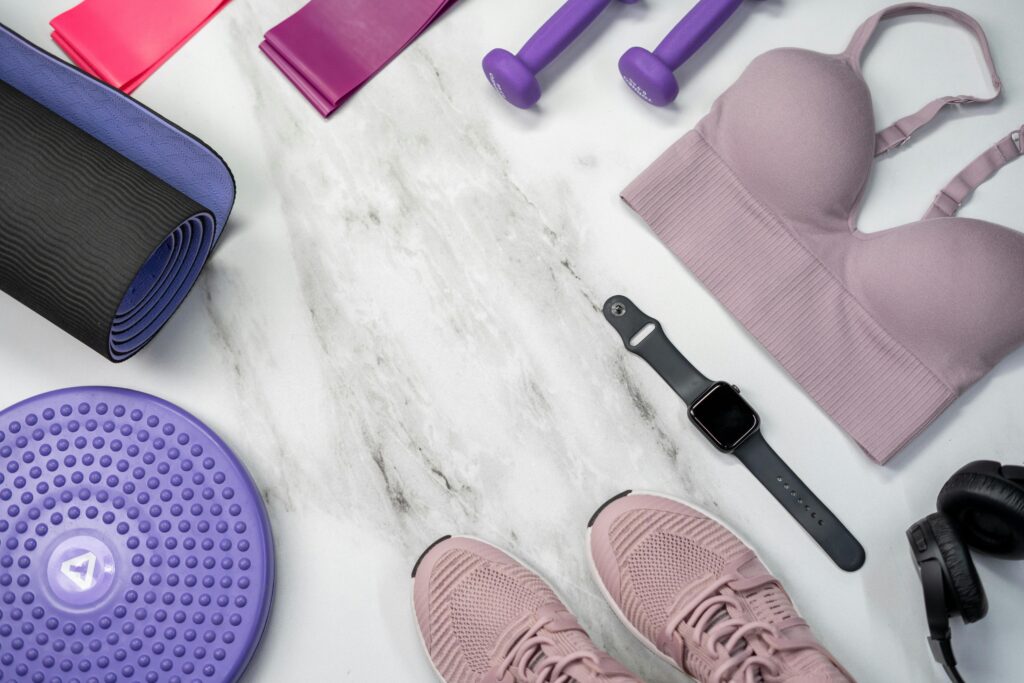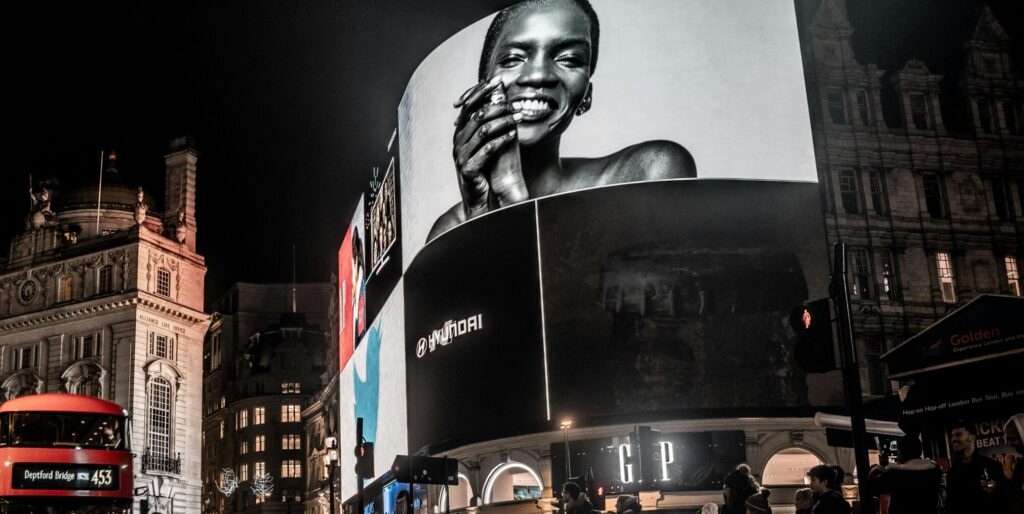Top of the funnel marketing is the activities you carry out to create initial awareness about your brand, product or event. If you think of your customers’ journey as a metaphorical funnel, this is the first step on their path to purchase, spreading awareness and generating education and excitement about what you do.
Basically, this is your chance to show off. It’s your first impression, and what you do now could dictate how many people continue further down the funnel and end up buying from you. But just how much showing off should you do, and when it comes to your paid media budget, how much of it should be spent here?
There has been a change in recent years in how brands apportion budget across bottom of funnel, top, and everything in between. A survey from the WFA and Ebiquity across 92 global brand leaders who manage upwards of $50bn in annual advertising spend found that 35% of respondents plan on increasing their brand spend in the new year:

We’re about to answer all your questions, and maybe even some new ones you hadn’t thought of yet. As experts in all things paid media, we know how to get the best out of your budget and spend it in all the right areas, so get ready to open your funnel’s floodgates – customers are on their way.
TOPICS COVERED IN THIS POST
- Examples of Top of Funnel Marketing
- What is The Difference Between Top of Funnel and Bottom of Funnel In Paid Media?
- How Should Brands Allocate Their Paid Media Budgets For Full Funnel Strategies?
- Where Will You Get The Most Return For Your Investment?
- Performance Marketing vs Brand Marketing
- It’s All About Incrementality
- How To Measure Top of Funnel Marketing
- Questions That We Get Asked Most About Top of Funnel Paid Media
EXAMPLES OF TOP OF FUNNEL MARKETING
There are plenty of ways to start your top of funnel marketing efforts, and we’re not going to tell you which one is best for you here – it very much depends on your business and your target audience. But there are a few tried and tested methods that are more likely to draw your audience in and get eyes looking in your direction.
SOCIAL MEDIA
This is often the first place potential customers will see you, either through organic means or because you’ve paid to promote a post. 72% of people use some form of social media, so you can pretty much guarantee your target audience will be out there. What’s great about this form of top of funnel marketing is how easily it can spread, taking something that was focused on just one group of customers and opening it up to a whole new potential audience. You could think about top of funnel Facebook ads or top of funnel Google ads as good examples.
EVENTS
Getting yourself seen at a live event can help you make a real solid connection with a potential customer. They stand apart from digital-only channels, as the people attending will likely already have a passing interest in your area of work, putting them slightly further ahead on their sales journey. Top tip: You can film these events and share them on other channels later on. Two top of funnel strategies for the price of one!
VIDEO
One top of funnel advertising technique that’s really taking off is video. Good quality video can not only showcase your services, but can also be used across different marketing channels such as your website, paid media and social media. You can even use video as a ready-made demo – going in with a hard-sell at top of funnel rarely works, so personalised 1-2-1 video demons can really get your message across without scaring people away. 75% of people are already watching short-form video content on their phones – make sure they’re watching you.
Despite what you might read on LinkedIn, print isn’t dead. In 2023, Statista studies showed that direct mail delivered a ROI of 43%, which is a pretty staggering figure compared to lots of other marketing techniques. It can be a great way to deliver a message directly to the person you want to receive it, and as it comes through the post, it can already feel more personal than a targeted ad online. If done in sync with other methods, print media can really hammer your pitch home.
OUT OF HOME (OOH)
Out of home advertising, such as digital displays, billboards and bus ads is a highly visual, high impact way to share your services. Done well, these top of funnel ads can be seen by hundreds of thousands of people, and while it’s not going to be targeted, a scattergun approach will surely hit some of the right people. Just think how often you see a clever London Underground ad shared online or how that catchy new digital billboard for a skincare brand pops up in your head when you’re looking for gift ideas, and with a projected revenue for both traditional and digital OOH reaching over $49bn in 2024, this certainly is a channel to keep in mind.
TV ADVERTISING
Possibly the most expensive top of funnel marketing method is TV, and there’s some debate about whether it’s worth your investment. But given how 87% of the UK’s population watch TV adverts, we think it certainly is. The challenge is you have to move with the times. Video on demand and steaming services are making old methods of TV advertising seem outdated, so you need to use TV as part of a connected marketing approach to truly get the returns you desire.
TOP AND BOTTOM OF FUNNEL PAID MEDIA DIFFERENCES
While top of funnel marketing is all about creating awareness, bottom of funnel is all about sealing the deal. If you’ve done the first step well, you’ll have queues of customers lining up to use your services, and this is where bottom of the funnel paid media really comes into its own.
There are different tactics to consider towards the bottom of the funnel; ones designed to remind customers why they were first interested, highlight the benefits of your service, personalise your approach and make it easy for customers to reach that finishing line. Here are just a few ways you can go about it:
RETARGETING
Retargeting uses information that you’ve gathered at an earlier stage of the sales funnel to remind potential customers about what you can offer. These kinds of ads often take the form of social media ads or Google ads, leaving people to think, “That’s so weird, I was just thinking about that…”
FREE TRIALS, SAMPLES, AND DEMOS
Why talk about your product when you can show it live in action? A free trial not only gives customers a chance to try before they buy, it also builds trust between them and your brand, making them more likely to come back to you for more services in the future.
EMAIL MARKETING
We’ve all seen the emails – ‘looks like you’ve left something in your basket…’ And they work, the Klaviyo benchmark report stating that abandoned cart emails convert at ~40% (vs standard email campaigns at 21%). That personalised message reminds us that we were part way through doing something that we found important, and quickly pulls us back into a key part of the purchase journey.
PAID SEARCH (GOOGLE ADS)
Paid search lets you target keywords based on what your customers are already searching for. At the bottom of the funnel, this is a great way to get them looking back in your direction. Google can be your biggest friend throughout the funnel, so use it wisely.
ALLOCATING MEDIA BUDGETS FOR THE FULL FUNNEL
Are we paid media experts? Yes, but can we predict the future? Well, not always. The way you split your paid media budget across your full funnel strategy can depend on a few different objectives, and ultimately will come down to what you hope your strategy will achieve. Things worth considering are:
YOUR END GOAL
What do you want to come out of your funnel? Sales? Loyalty? Traffic? Think about your desired outcome before you start, as this will help make your mind up about what to spend where.
WHO DO YOU WANT TO ATTRACT?
Different audiences will be looking for your services in different places, so it makes sense to put more of your budget where your target market spends most of their time. If you’ve got an active market on TikTok, focus your spending there. If your audiences are already aware of what you do, you could spend more money at the end of the funnel to attract more sales on Google Ads.
WHERE WILL YOU GET THE BEST ROI?
One common distribution rule is 70-20-10. This theory suggests you spend 70% of your budget on proven channels – such as ones that have consistently worked in the past – 20% on channels your data predicts might work this time, and 10% on testing new ideas.
Another theory suggests a 60-30-10 split, but it’s not a like-for-like comparison. With this approach, 60% of your paid media budget gets spent on awareness, 30% goes on remarketing towards the bottom of the funnel, and 10% goes towards hot leads to finalise deals.
PERFORMANCE MARKETING VS BRAND MARKETING
Not all marketing strategies are born equal. Performance marketing focuses on quick, short-term wins, while brand marketing is all about raising awareness. The type of strategy you’re going for will play a big role in deciding how to allocate your budget.
Brand building and performance should work in synergy and help each other out. A study from IPA Databank into Marketing Effectiveness in the Digital Era showed the relationship between brand and sales activation over time, and the uplift over different timescales:

Whatever you do, it’s always important to test and learn, ensuring you assign accurate windows for learning and budget to each of the strategies you adopt. Just because something works this time, it doesn’t mean it’ll work again the next. So test your approach and learn from it for future funnels.
IT’S ABOUT INCREMENTALITY
Changing your approach to paid media budget allocation can’t always guarantee immediate results. That’s what it pays to think about incrementality. This is the actual business impact you’ll see as a result of certain activities – for example the amount of web traffic brought in by a social media campaign, or the amount of sales a new landing page delivers. While it can be tempting to think new sales are coming directly from campaign A, B or C, incrementality allows you to be more specific, helping you accurately highlight where your budget is doing its best work.
With up to 83% of CEOs looking to marketing as a growth metric for their business, it’s vital that you can specify how and where marketing is helping. It quite literally pays to do your research, and with incrementality, you can make sure every penny counts.
MEASURING THE RESULTS OF TOP OF FUNNEL MARKETING
Once you’ve done all the hard work of getting your marketing funnel up and running, you’ll want to see the results. Some people will promise you X% return on your investment, but not us. We’ll tell it how it is – that some strategies will work, some won’t, and some will be worth trying again in the future. There are a few important KPIs to look at when measuring your top of funnel metrics:
- Your reach. Check out how many people have seen your marketing. They’re all now in your funnel, enjoy the ride.
- Click-through rate. These people haven’t only seen your message – they’ve liked it enough to want to find out more.
- Time on site. Have they clicked through and bounced away again? If so, that’s your bounce rate figure. If they’ve stayed for a while, look at how long they’ve hung around and where their journey has taken them.
- New visitors. Are you attracting returning customers or bringing new people in with your messaging? If it’s more the former, you might need to try a new approach to bring in a new audience.
- Campaign engagement. One of the biggest indicators of top of funnel advertising success is your initial engagement rates. On social media, this could be likes, comments and shares, while you should also look at event footfall, podcast listens and video views.
WHAT WE GET ASKED ABOUT TOP OF FUNNEL PAID MEDIA
- What are top of funnel metrics? These differ across campaign, business, objectives, and more. Roughly speaking, you could observe: impressions (total ad views), reach (number of unique users who see the ad), click-through rate (CTR) for awareness campaigns, video views (for video ads), and engagement metrics like likes or shares in social campaigns, to name a few.
- How do you increase the top of funnel? Using broad targeting campaigns is a common strategy, utilising audience segments such as in-market audiences, interest-based audiences, or lookalike audiences. Use high-visibility formats like video ads, display ads, or social media carousel ads. Essentially, the more budget you allocate to broader brand focussed campaigns, assuming they have a strategic focus, you will be getting new eyes on your brand and increasing the top of funnel.
- What are top of funnel keywords? The broader and more informational the keyword, the further up the funnel (in most cases). For example, keywords including ‘how to’ or ‘best’ may be further up the funnel than a keyword that defines exactly what the searcher is looking for.
- What is the middle of the funnel? The middle of the funnel in focuses on nurturing through light touch retargeting campaigns, gated content, or direct response ads highlighting benefits. It’s the stage where users show more intent, like signing up for events, requesting newsletters, etc.
- What ad network is best for top of funnel? Meta (Facebook/Instagram) and YouTube are excellent for top-of-funnel paid media due to their strong visual formats and ability to build awareness. Google Display Network also works well for reaching wide audiences with high-volume impressions.
- Can you do top of funnel advertising on Google? Absolutely, GDN, YouTube and Discovery ads offer advertisers the opportunity to capture attention and drive vast reach using highly visual assets across millions of placements.
- How do you do top of funnel for B2B? We get asked this alot. For B2B, top-of-funnel strategies can include LinkedIn Ads targeting job titles or industries, GDN to target in-market audiences, or using Meta Ads with a focus on business interests. The content should offer high-value resources, and we’ve found great success with the likes of eBooks or industry reports.


